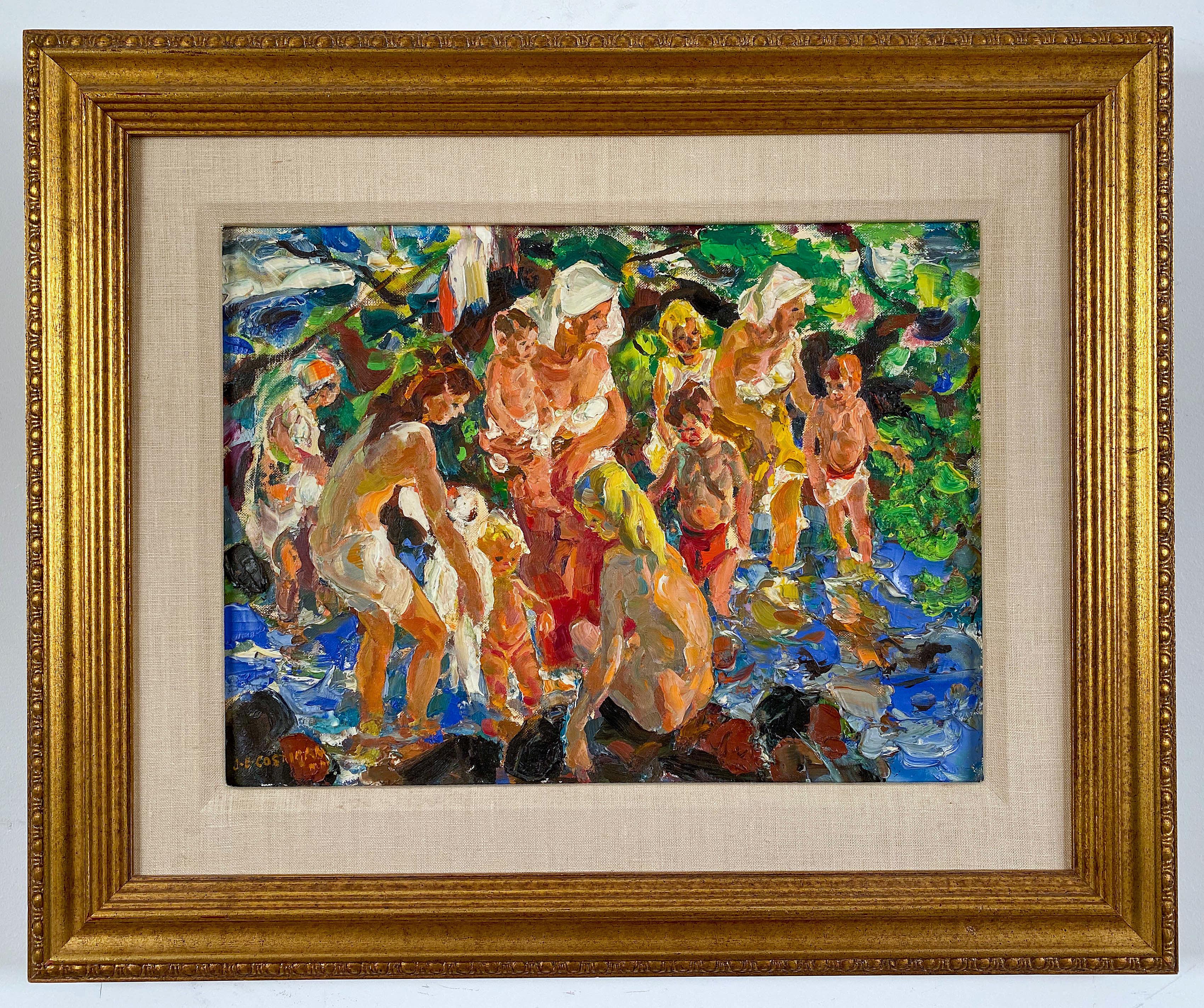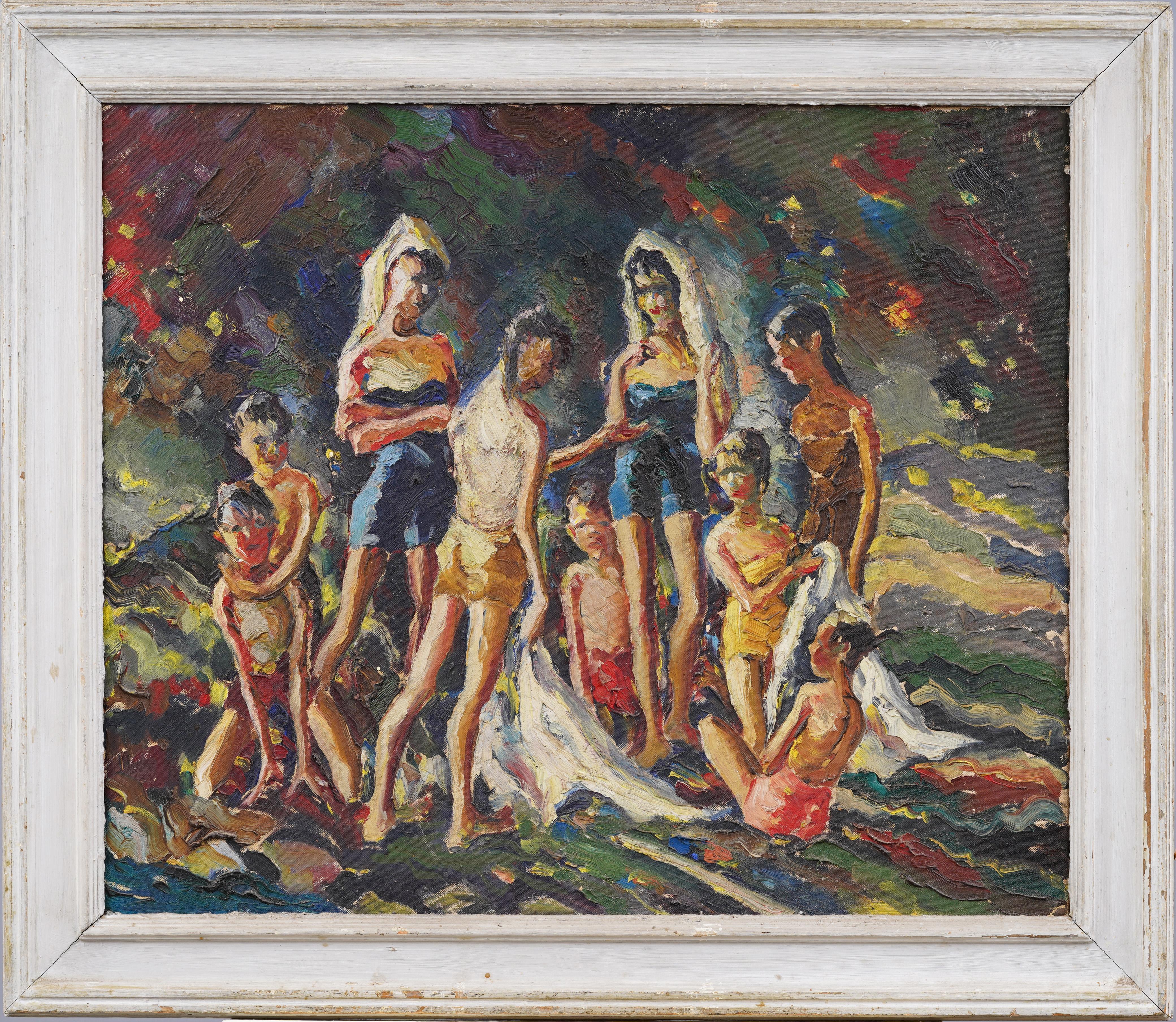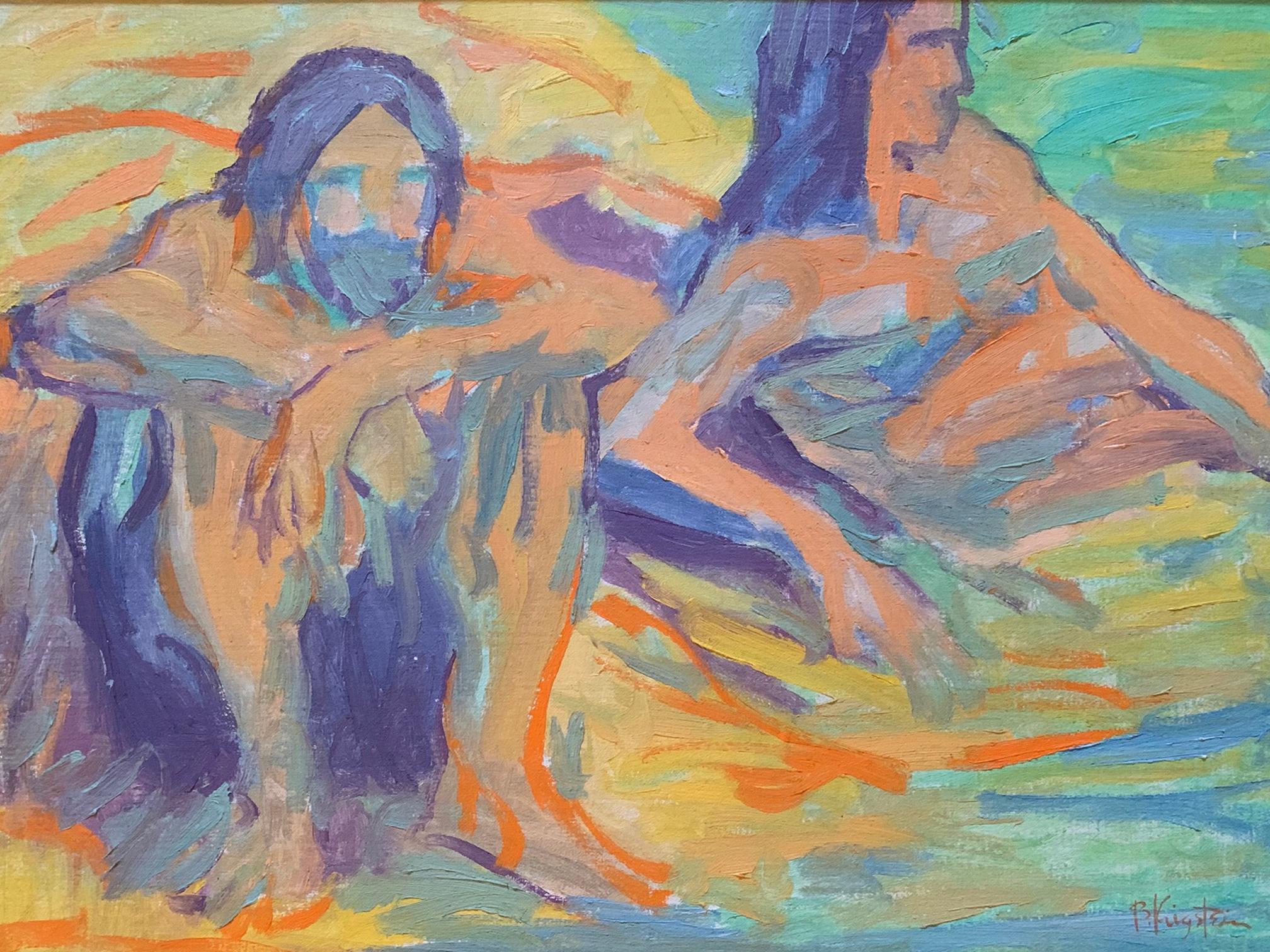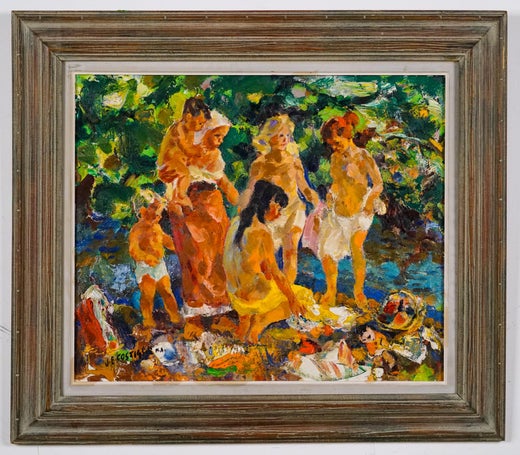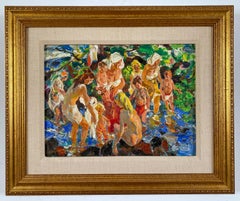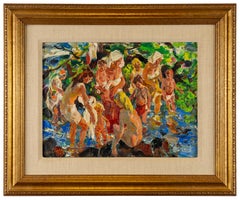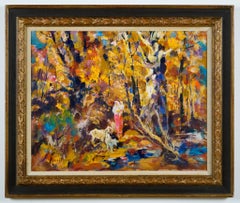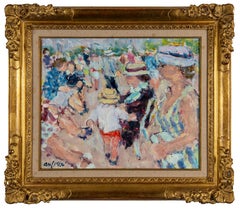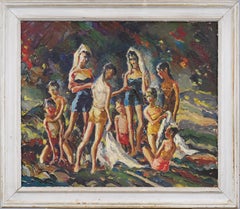Items Similar to Bathers
Want more images or videos?
Request additional images or videos from the seller
1 of 8
John Edward CostiganBathers1950's
1950's
$9,850
£7,372.58
€8,519.10
CA$13,658.67
A$15,299.46
CHF 7,954.02
MX$188,917.56
NOK 101,327.94
SEK 95,789.81
DKK 63,574.20
Shipping
Retrieving quote...The 1stDibs Promise:
Authenticity Guarantee,
Money-Back Guarantee,
24-Hour Cancellation
About the Item
John Edward Costigan, N.A.
American, 1888-1972
Bathers
Oil on canvas
Signed ‘J.E. Costigan N.A.’ lower left
20 by 24 in. W/frame 26 by 30 in.
John Costigan was born of Irish-American parents in Providence, Rhode Island, February 29, 1888. He was a cousin of the noted American showman, George M. Cohan, whose parents brought the young Costigan to New York City and was instrumental in starting him on a career in the visual arts. They were less successful in encouraging him to pursue formal studies at the Art Students League (where, however, he later taught) than in exposing him to the commercial art world through the job they had gotten him with the New York lithographing firm that made their theatrical posters.
At the H. C. Miner Lithographing Company, Costigan worked his way up from his entry job as a pressroom helper, through various apprenticeships, to the position of sketch artist. In the latter capacity he was an uncredited designer of posters for the Ziegfeld Follies and for numerous silent films. Meanwhile, he had supplemented his very meager formal studies in the fine arts with a self-teaching discipline that led to his first professional recognition in 1920 with the receipt of prizes for an oil painting and watercolor in separate New York exhibitions.
A year earlier, Costigan had wed professional model Ida Blessin, with whom he established residence and began raising a family in the sleepy little rural New York hamlet of Orangeburg, the setting for the many idyllic farm landscapes and wood interiors with which he was to become identified in a career that would span half a century.
John Costigan’s first national recognition came in 1922 with his winning of the coveted Peterson Purchase prize of the Art Institute of Chicago for an oil on canvas, “Sheep at the Brook.” It marked the start of an unbroken winning streak that would gain him at least one important prize per year for the remainder of the decade. The nation’s art journalists and critics began to take notice, making him the recurring subject of newspaper features and magazine articles. The eminent author and critic Edgar Holger Cahill was just a fledgling reporter when he wrote his first feature, “John Costigan Carries the Flame,” for Shadowland Magazine in 1922. Costigan had his first one-man show of paintings at the Rehn Gallery on New York’s 5th Avenue in November, 1924, to be followed less than three years later by another at the Art Institute of Chicago. In addition, Costigan’s work has been—and continues to be included, side-by-side with that of some of America’s most high-profile artists, in museum and gallery exhibitions throughout the country. His renown had peaked in the early 1930s, by which time his work had been honored with nearly every major award then being bestowed in the fine arts and had been acquired for the permanent collections of several prestigious American museums, including New York’s Metropolitan (which only recently, in 1997, deaccessioned his “Wood Interior,” acquired in 1934).
Although Costigan’s celebrity had ebbed by the late 1930s, the Smithsonian Institution saw fit in 1937 to host an exhibition exclusively of his etchings. And, in 1941, the Corcoran Gallery (also Washington, D.C.) similarly honored him for his watercolors. (Another Washington institution, the Library of Congress, today includes 22 Costigan etchings and lithographs in its permanent print collection.)
During World War II, Costigan returned briefly to illustrating, mainly for Bluebook, a men’s pulp adventure magazine. A gradual revival of interest in his more serious work began at the end of the war, culminating in 1968 with the mounting of a 50-year Costigan retrospective at the Paine Art Center and Arboretum in Oshkosh, Wisconsin. Oils, watercolors and prints were borrowed from museums and private collections throughout the country, and the exhibition was subsequently toured nationally by the Smithsonian Institution.
John Costigan died of pneumonia in Nyack, NY, August 5, 1972, just months after receiving his final prestigious award —the Benjamin West Clinedinst Medal of the Artist’s Fellowship, Inc., presented in general recognition of his “...achievement of exceptional artistic merit...” in the various media he had mastered in the course of his career.
This painting depicts one of the artist's favorite themes --the farm family bathing in the wooded creek that bordered his property in Orangeburg NY. Most of these were titled simply "Bathers" or "Bathing Group." This painting is truly representative of the artist's work in oils, particularly his later work.
Provenance:
Private Collection, New York
Alexander Avenard Collection
Le Trianon Fine Art & Antiques, Sheffield, MA.
Art C309
- Creator:John Edward Costigan (1888 - 1972, American)
- Creation Year:1950's
- Dimensions:Height: 26 in (66.04 cm)Width: 30 in (76.2 cm)Depth: 2 in (5.08 cm)
- Medium:
- Movement & Style:
- Period:
- Condition:
- Gallery Location:Sheffield, MA
- Reference Number:Seller: Art C3091stDibs: LU70037859322
John Edward Costigan
An American Painter Compositional painter of figures and country animals; watercolor painter Costigan was a largely self-taught artist. He moved from Providence, Rhode Island to New York City as an orphaned teenager in 1904 to work for a commercial poster company. It was here that he learned the rudiments of drawing and painting, skills he furthered with informal study at New York's Kit Kat Club, a popular artists' hangout. Costigan achieved national fame as a painter and printmaker in the1920s and 30s. He won numerous prestigious awards and, despite his lack of formal artistic training, was elected a full member of the National Academy of Design. In 1937 the Smithsonian Institution held a one-person exhibition of his graphic works. Famed American printmaker John Taylor Arms praised Costigan as "a brilliant etcher, particularly noted for his interpretation of life on the American farmstead." Today prints by Costigan can be found in private and public collections around the nation, including the Prints and Photographs Division of the Library of Congress in Washington, which owns twenty-two. The Swope exhibition is the largest devoted to Costigan's work since the late 1960s. Many of the forty-five prints in the exhibition are from the Swope's own extensive holdings of Costigan's works. Other are being lent by private collectors from around the country.
About the Seller
4.0
Vetted Professional Seller
Every seller passes strict standards for authenticity and reliability
1stDibs seller since 2017
53 sales on 1stDibs
Typical response time: 10 hours
- ShippingRetrieving quote...Shipping from: Sheffield, MA
- Return Policy
Authenticity Guarantee
In the unlikely event there’s an issue with an item’s authenticity, contact us within 1 year for a full refund. DetailsMoney-Back Guarantee
If your item is not as described, is damaged in transit, or does not arrive, contact us within 7 days for a full refund. Details24-Hour Cancellation
You have a 24-hour grace period in which to reconsider your purchase, with no questions asked.Vetted Professional Sellers
Our world-class sellers must adhere to strict standards for service and quality, maintaining the integrity of our listings.Price-Match Guarantee
If you find that a seller listed the same item for a lower price elsewhere, we’ll match it.Trusted Global Delivery
Our best-in-class carrier network provides specialized shipping options worldwide, including custom delivery.More From This Seller
View AllBathing Group
By John Edward Costigan
Located in Sheffield, MA
John Edward Costigan, N.A.
American, 1888-1972
Bathing Group
Oil on canvas board
Signed ‘J.E. Costigan N.A.’ lower left
12 by 16 in. W/frame 20 by 24 i...
Category
1950s Post-Impressionist Figurative Paintings
Materials
Oil
Bathing Group
By John Edward Costigan
Located in Sheffield, MA
John Edward Costigan
American, 1888-1972
Bathing Group
Oil on canvas board
12 by 16 in, w/ frame 19 by 23 in
Signed ‘J.E. Costigan N.A.’ lower left
John Costigan was born of Irish-...
Category
Mid-20th Century Modern Paintings
Materials
Oil
Woman and Child
By John Edward Costigan
Located in Sheffield, MA
John Edward Costigan, N.A.
American, 1888-1972
Woman and Child
Oil on canvas
Signed ‘J.E. Costigan N.A.’ lower left
24 by 30 in. W/frame 32 by 38 in.
John Costigan was born of Irish-American parents in Providence, Rhode Island, February 29, 1888. He was a cousin of the noted American showman, George M. Cohan, whose parents brought the young Costigan to New York City and was instrumental in starting him on a career in the visual arts. They were less successful in encouraging him to pursue formal studies at the Art Students League (where, however, he later taught) than in exposing him to the commercial art world through the job they had gotten him with the New York lithographing firm that made their theatrical posters.
At the H. C. Miner Lithographing Company, Costigan worked his way up from his entry job as a pressroom helper, through various apprenticeships, to the position of sketch artist. In the latter capacity he was an uncredited designer of posters for the Ziegfeld Follies and for numerous silent films. Meanwhile, he had supplemented his very meager formal studies in the fine arts with a self-teaching discipline that led to his first professional recognition in 1920 with the receipt of prizes for an oil painting and watercolor in separate New York exhibitions.
A year earlier, Costigan had wed professional model Ida Blessin, with whom he established residence and began raising a family in the sleepy little rural New York hamlet of Orangeburg, the setting for the many idyllic farm landscapes and wood interiors with which he was to become identified in a career that would span half a century.
John Costigan’s first national recognition came in 1922 with his winning of the coveted Peterson Purchase prize of the Art Institute of Chicago for an oil on canvas, “Sheep at the Brook.” It marked the start of an unbroken winning streak that would gain him at least one important prize per year for the remainder of the decade. The nation’s art journalists and critics began to take notice, making him the recurring subject of newspaper features and magazine articles. The eminent author and critic Edgar Holger Cahill was just a fledgling reporter when he wrote his first feature, “John Costigan Carries the Flame,” for Shadowland Magazine in 1922. Costigan had his first one-man show of paintings at the Rehn Gallery on New York’s 5th Avenue in November, 1924, to be followed less than three years later by another at the Art Institute of Chicago. In addition, Costigan’s work has been—and continues to be included, side-by-side with that of some of America’s most high-profile artists, in museum and gallery exhibitions throughout the country. His renown had peaked in the early 1930s, by which time his work had been honored with nearly every major award then being bestowed in the fine arts and had been acquired for the permanent collections of several prestigious American museums, including New York’s Metropolitan (which only recently, in 1997, deaccessioned his “Wood Interior,” acquired in 1934).
Although Costigan’s celebrity had ebbed by the late 1930s, the Smithsonian Institution saw fit in 1937 to host an exhibition exclusively of his etchings. And, in 1941, the Corcoran Gallery (also Washington, D.C.) similarly honored him for his watercolors. (Another Washington institution, the Library of Congress, today includes 22 Costigan etchings and lithographs in its permanent print collection.)
During World War II, Costigan returned briefly to illustrating, mainly for Bluebook, a men’s pulp adventure magazine. A gradual revival of interest in his more serious work began at the end of the war, culminating in 1968 with the mounting of a 50-year Costigan retrospective at the Paine Art Center and Arboretum in Oshkosh, Wisconsin. Oils, watercolors and prints were borrowed from museums and private collections throughout the country, and the exhibition was subsequently toured nationally by the Smithsonian Institution.
John Costigan died of pneumonia in Nyack, NY, August 5, 1972, just months after receiving his final prestigious award —the Benjamin West Clinedinst Medal of the Artist’s Fellowship, Inc., presented in general recognition of his “...achievement of exceptional artistic merit...” in the various media he had mastered in the course of his career.
This painting depicts one of the artist's favorite themes --the farm family bathing...
Category
1940s Post-Impressionist Landscape Paintings
Materials
Oil
Personnages Dans un Parc
By Pierre Anfosso
Located in Sheffield, MA
Pierre Anfosso
French, 1928-2004
Personnages Dans un Parc
Oil on Canvas
15 by 18 in, w/ frame 21 ½ by 24 ½ in
Signed lower left
Pierre Anfosso (1 Dece...
Category
Mid-20th Century Expressionist Figurative Paintings
Materials
Oil
Afternoon on the Beach
By Suzanne Demarest
Located in Sheffield, MA
Suzanne Demarest
French, 1900-1985
Afternoon on the Beach
Oil on canvas
20 by 24 in, w/ frame 27 ½ by 31 ½ in
Signed lower right
Suzanne was born in 1900 and raised in the mountains, where her appreciation for nature all began. During her childhood, she also developed a great love for music, particularly the violin and she once remarked, "Painting is my violin."
She studied in Nice and Cannes and much of her work depicts the delicate but wonderful light and sunshine of the South of France. She also studied at the Royal Academy in England.
She was active in Paris sketching...
Category
Mid-20th Century Impressionist Paintings
Materials
Oil
Figures in the Forest
Located in Sheffield, MA
Carl Carlsen
Danish, 1855-1917
Figures in the Forest
Oil on canvas
Signed and dated ‘Carl Carlsen 1900’ lower right
24 ½ by 30 ½ in. w/frame 31 by 36 i...
Category
Early 1900s Impressionist Landscape Paintings
Materials
Oil
You May Also Like
Antique American Impressionist New England Beach Bathers Landscape Oil Painting
Located in Buffalo, NY
Nicely painted mid century impressionist bather scene by John Edward Costigan (1888 - 1972). Oil on board. Framed. Signed verso.
Category
1940s Impressionist Figurative Paintings
Materials
Canvas, Oil
Fernande Horovitz-Edwards, Bathers, Large Oil on Canvas, 1930s
Located in Saint Amans des cots, FR
Large Oil on Canvas by Fernande Horovitz-Edwards, France, 1930s - "Bathers". This large oil on canvas by Fernande Horovitz-Edwards, titled Bathers, dates from the 1930s and showcases...
Category
1930s Post-Impressionist Figurative Paintings
Materials
Canvas, Oil
Bathers, Oil on Canvas, 1914
By Roger Grillon
Located in Saint Amans des cots, FR
Oil on canvas by Roger GRILLON (1881-1938), France, 1914. "Bathers". With frame: 114x94 cm - 44.9x37 inches ; without frame: 92x73cm - 36.2x28.75 inches. 30F format. Signed lower lef...
Category
1910s Impressionist Figurative Paintings
Materials
Canvas, Oil
‘The Bathers’ by Bernard Krigstein - Colorful Post Impressionist Figurative
Located in Carmel, CA
Bernard Krigstein (March 22, 1919 – January 8, 1990) was an American illustrator and Ashscan school painter who received acclaim for his innovative a...
Category
Late 20th Century Modern Figurative Paintings
Materials
Oil, Canvas
Antique French Bathers at the Stream Figurative Landscape
Located in Douglas Manor, NY
5-3601 Family bathers by the stream
Set in a vintage wood frame
Image size 9.5x7.5"
Category
1940s Figurative Paintings
Materials
Gouache
Les Baigneuses - Post Impressionist Figures in Landscape Oil by Pierre Montezin
By Pierre Eugène Montezin
Located in Marlow, Buckinghamshire
Signed oil on canvas figures in riverscape circa 1910 by sought after French impressionist painter Pierre Eugene Montezin. The work depicts bathers in a river on a sunny summer's day...
Category
1910s Impressionist Figurative Paintings
Materials
Canvas, Oil
More Ways To Browse
Frey Pottery
Giraffe Plate
Globe Drinks
Green Catalin
Gregory Halpern
Hector Ayala
Helen Frankenthaler Lincoln Center
Hokusai Fuji
Hunt Slonem Serigraph
Hunter S Thompson
Isle Of Skye
Israeli Coins
Japanese Denim Vintage
Jean Jansem On Sale
Jean Philippe Kadzinski
Jean Philippe Richard
Joan Miro La Melodie Acide
John Lennon Lyrics
